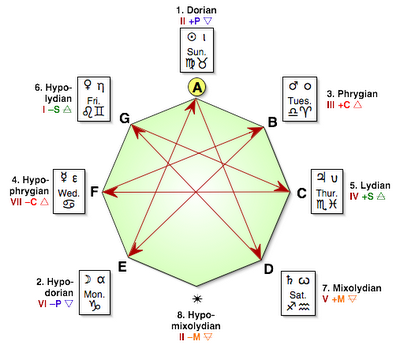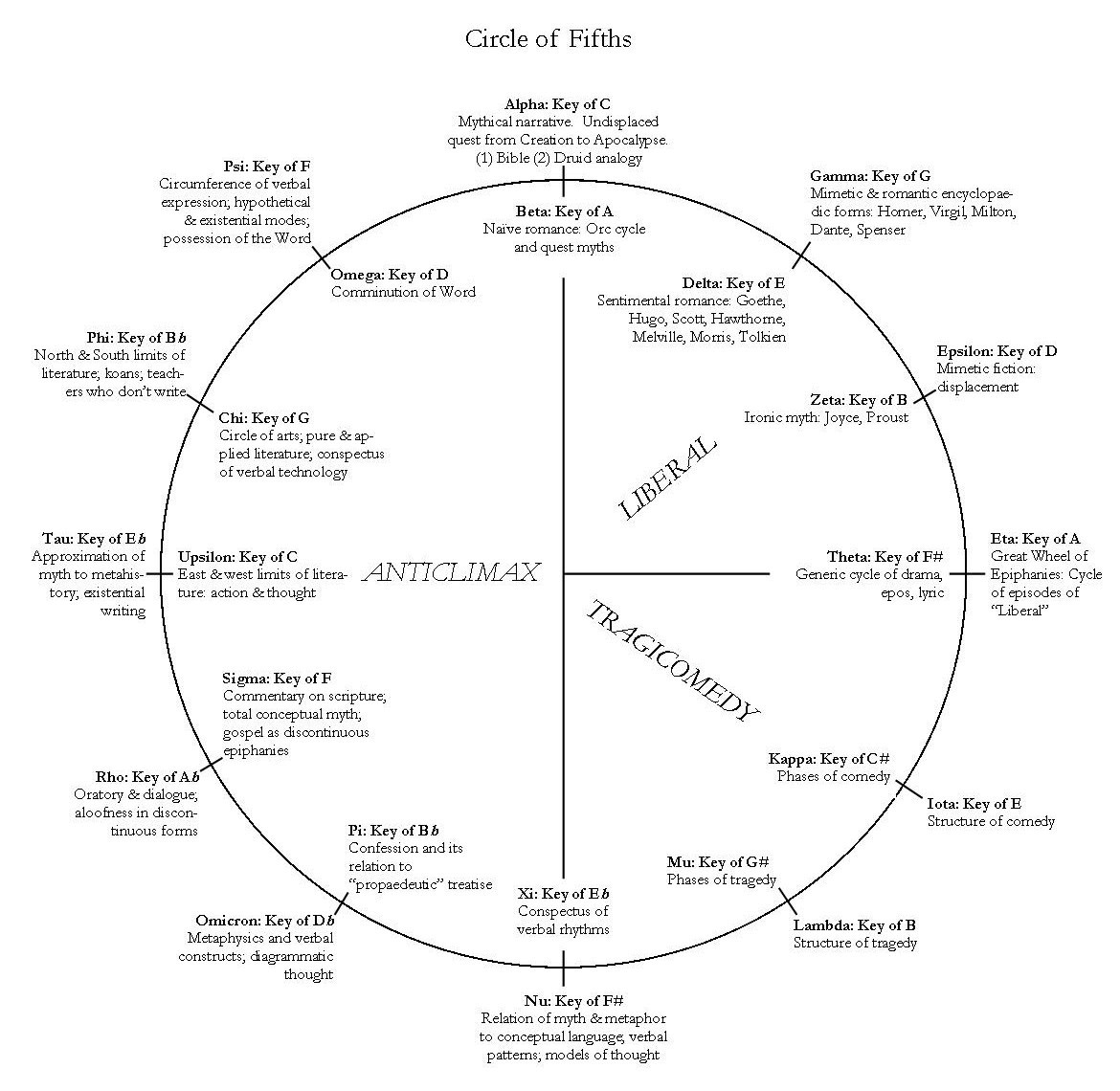
Responding to Peter Yan and Adam Bradley:
Yes, Frye certainly did know about the Greek modes. In “Modal Harmony in Music” he writes:
In the sixteenth century much greater freedom of tonality was available. The major and minor modes were then celled Ionian and Aeolian respectively, but four others were used. Arranged in order of sharpness, they are: Lydian (F to F on white notes: present major with raised fourth); Ionian (C to C: present major); Mixolydian (G to G: present major with lowered seventh); Dorian (D to D: present natural minor with raised sixth); Aeolian (A to A: present minor); Phrygian (E to E: present natural minor with lowered seventh). A seventh mode, the Locrian, B to B or Phrygian with lowered fifth, had probably only a theoretical existence. These four additional modes, like the two we now have, ended on the tonic chord. Thus, if all modes were impartially used today, a piece ending on G would have a key signature of two sharps in the Lydian modes, one in the major, none in Mixolydian, one flat in Dorian, two in minor, three in Phrygian. Or a piece with a key signature of one sharp could be C Lydian, G major, D Mixolydian, A Dorian, E minor, or B Phrygian. (Northrop Frye’s Fiction and Miscellaneous Writings, 185)
And in “Baroque and Classical Composers” Frye writes:
When rhythm changes from 4/4 to 3/2 the minim of the latter = crochet of former. Key signatures only either none or one flat, & occasionally two flats: no sharps. Fellowes finally, bless his heart, coughs up some dope on the modes. If the piece has no flat in the signature, look at the last bass note and that will give you the mode. A = Aeolian (minor scale), B = Locrian (theoretically: it’s never used), C = Ionian (major scale), D = Dorian, E = Phrygian, F = Lydian, G = Mixolydian. That’s if the melody is authentic: if it’s plagal then prefix hypo to the mode. If there is a flat, transpose a fourth down or fifth up (G with a flat = D without one); if two, tr. [transpose] a tone up. Hence many key signatures until the 18th c. were a flat or a sharp short. Modulation & equal temperament go together. (ibid., 175)
As for the circle of fifths, sometime in the late 1950s or early 1960s Frye provided a schematic for the circle as a way of outlining the twenty‑four parts in the first three units of his ogdoad: Liberal, Tragicomedy, and Anticlimax. The twenty‑four letters of the Greek alphabet provided Frye a convenient name for each of the twelve major and the twelve minor keys. C = alpha, A = beta, G = gamma, etc. Frye didn’t actually draw a diagram, but in his Notebooks for “Anatomy of Criticism” (paragraphs 57, 58, 63, and 73 of Notebook 18), he set down the constituents of a diagram and gave a brief description of the thematic contents of each of the twenty‑four parts, illustrating what he means by saying that the circle of fifths provides a “symmetrical grammar” (Spiritus Mundi, 118).

CIRCLE OF FIFTHS. MAJOR KEYS.
Alpha: Key of C
Mythical narrative. Undisplaced quest from Creation to Apocalypse. (1) Bible (2) Druid analogy
Gamma: Key of G
Mimetic & romantic encyclopaedic forms: Homer, Virgil, Milton, Dante, Spenser
Epsilon: Key of D
Mimetic fiction: displacement
Eta: Key of A
Great Wheel of Epiphanies: Cycle of episodes of “Liberal”
Iota: Key of E
Structure of comedy
Lambda: Key of B
Structure of tragedy
Nu: Key of F#
Relation of myth & metaphor to conceptual language; verbal patterns; models of thought
Omicron: Key of Db
Metaphysics and verbal constructs; diagrammatic thought
Rho: Key of Ab
Oratory & dialogue; aloofness in discontinuous forms
Xi: Key of Eb
Approximation of myth to metahistory; existential writing
Phi: Key of Bb
North & south limits of literature; koans; teachers who don’t write
Psi: Key of F
Circumference of verbal expression; hypothetical & existential modes; possession of the Word
CIRCLE OF FIFTHS. MINOR KEYS
Beta: Key of A
Naïve romance; Orc cycle and quest myths
Delta: Key of E
Sentimental romance: Goethe, Hugo, Scott, Hawthorne, Melville, Morris, Tolkien
Zeta: Key of B
Ironic myth: Joyce, Proust
Theta: Key of F#
Generic cycle of drama, epos, lyric
Kappa: Key of C#
Phases of comedy
Mu: Key of G#
Phases of tragedy
Tau: Key of Eb
Conspectus of verbal rhythms
Pi: Key of Bb
Confession and its relation to “propaedeutic” treatise
Sigma: Key of F
Commentary on scripture; total conceptual myth; gospel as discontinuous epiphanies
Upsilon: Key of C
East & west limits of literature: action & thought
Chi: Key of G
Circle of arts; pure & applied literature; conspectus of verbal technology
Omega: Key of D
Comminution of Word
If we begin with the first of the major and minor keys (C and A), placing them at the top of a circle and proceeding clockwise, the following diagram results:

To the left of the first five entries (Alpha through Epsilon) in paragraph 57 of Notebook 18, Frye inserted in very small script, respectively, the abbreviations “r.,” “pr.,” “gr,” “y,” and “or.” These stand for red, purple, green, yellow, and orange, and are associated with the musical keys in parentheses at the end of each numbered section. The color associated with each musical key was for Frye purely arbitrary, deriving, as he writes in Notebook 21, from the “color scheme imposed by the wooden blocks of my childhood. Thus E is always green, B blue, A violet, F black, D orange, C red in music but not verbally, G red verbally but colorless in music” (Northrop Frye Notebooks and Lectures on the Bible and Other Religious Texts, 176).
My best guess about the circle of fifths is that for Frye it was a purely mnemonic device. About one of his seven‑part schemes Frye wrote, “I think these associative fantasies may help to give at least a mnemonic structure to my material, as long as I don’t let them take me over.” The circle of fifths is perhaps just another of the scores of “zones” in Frye’s “memory theater,” which he developed over the years by way of Frances Yates and others as a way of cultivating the art of memory. See Imre Salusinszky, “Frye and the Art of Memory,” in Rereading Frye: The Published and Unpublished Words (Toronto: University of Toronto Press, 1999), 39–54.
